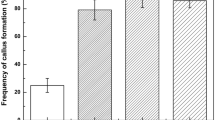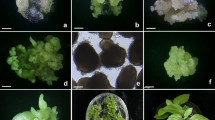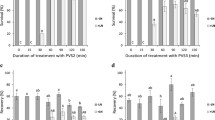Summary
A callus line of white clover capable of forming numerous meristemoids (meristematic cell masses) has been selected and subcultured on agar B5 medium containing 0.5 mg/l 2,4-D and 0.5 mg/l kinetin for three years. The meristematic callus was successfully cryopreserved by vitrification and subsequently regenerated plants. Preculturing callus in liquid B5 medium containing 0.6 M sorbitol at 25°C for 16 hr was essential to the process. Precultured samples (50 mg) were transferred to a 1.8 ml plastic cryotube and then 1 ml of a highly concentrated cryoprotective solution (designated PVS2) was added and mixed. After treatment with PVS2 at 25°C for 7 min or 0°C for 20 min, the sample was directly plunged into LN. After rapid warming, PVS2 was drained from the cryotubes and replaced twice with liquid B5 medium containing 1.2 M sucrose. Samples were transferred onto filter disc over agar B5 medium. Some surviving cells in the cryopreserved meristematic callus proliferated and produced new meristemoids. After 30 days the meristematic callus was transferred onto hormone-free MS agar medium. The meristemoids developed directly into shoots and spontaneously formed roots. Plant regeneration efficiency expressed as a percent of control amounted to about 90%. This vitrification method appears promising as a routine method for cryopreserving meristematic callus of white clover.
Similar content being viewed by others
Abbreviations
- B5:
-
Gamborg et al. (1968) medium
- 2,4-D:
-
2,4-dichrophenoxyacetic acid
- LN:
-
liquid nitrogen
- MS:
-
Murashige & Skoog (1962) medium
- PVS2:
-
plant vitrification solution of Sakai et al. (1991)
References
Bhojwani S.S. & D.W.R. White, 1982. Mesophyll protoplasts of white clover: isolation, culture and organogenesis. Plant Sci. Lett. 26: 265–271.
Bhojwani S.S., K. Mullins & D. Cohen, 1984. Intra-varietal variation for in vitro plant regeneration in the genus Trifolium. Euphytica 33: 915–921.
Gamborg O.L., R.A. Miller & K. Kojima, 1968. Nutrient requirements of suspension cultures of soybean root cells. Exp. Cell Res. 50: 151–158.
Kartha K.K., 1985. Meristem culture and germplasm preservation. In: K.K. Kartha (Ed), Cryopreservation of Plant Cells and Organs. pp. 115–134. CRC Press, Boca Raton, Florida.
Kartha K.K., L.C. Fowke, N.L. Leung, K.L. Caswell & I. Hakman, 1988. Induction of somatic embryos and plantlets from cryopreserved cell cultures of white spruce (Picea gluca). Plant Physiol. 132: 529–539.
Kobayashi S., A. Sakai & I. Oiyama, 1990. Cryopreservation in liquid nitrogen of cultured navel orange (Citrus sinensis Osb.) nucellar cells and subsequent plant regeneration. Plant Cell, Tissue & Organ Cult. 23: 15–20.
Langis R., B. Schnabel, E.D. Earle & P.L. Steponkus, 1989. Cryopreservation of Brassica campestris L. cell suspensions by vitrification. Cryo-Letters 10: 421–428.
Murashige T. & F. Skoog, 1962. A revised medium for rapid growth and bioassay with tobacco tissue culture. Physiol. Plant 15: 473–497.
Niino T., A. Sakai, H. Yakuwa & K. Nojiri, 1992. Cryopreservation of in vitro-grown shoot tips of apple and pear by vitrification. Plant Cell, Tissue & Organ Cult. 28: 261–266.
Rall W.F., 1987. Factors affecting the survival of mouse embryos cryopreserved by vitrification. Cryobiology 24: 387–402.
Sakai A., S. Kobayashi & I. Oiyama, 1991. Survival by vitrification of nucellar cells of navel orange (Citrus sinensis var. brasiliensis Tanaka) cooled to −196°C. J. Plant Physiol. 137: 465–470.
Towill L.E. & R.L. Jarret, 1992. Cryopreservation of sweet potato (Ipomoea batatas [L.] Lam.) shoot tips by vitrification. Plant Cell Reports 11: 175–178.
Uragami A., A. Sakai, M. Nagai & T. Takahashi, 1989. Survival of cultured cells and somatic embryos of Asparagus officinalis cryopreserved by vitrification. Plant Cell Reports 8: 418–421.
Vasil I.K., 1983. Regeneration of plants from single cells of cereals and grasses. In: P.F. Lurquin & A. Kleinhofs (Eds), Genetic Engineering in Eukaryotes. pp. 233–252. Plenum, New York.
White D.W.R., 1984. Plant regeneration from long term suspension cultures of white clover. Planta 162: 1–7.
Withers L.A., 1985. Cryopreservation of cultured plant cells and protoplasts. In: K.K. Kartha (Ed), Cryopreservation of Plant Cells and Organs, pp. 243–267. CRC Press, Boca Raton, Florida.
Yamada T., 1989. Selection of a highly-regenerative genotype of white clover (Trifolium repens L.) and plant regeneration from protoplasts derived from this genotype. Euphytica 44: 181–186.
Yamada T., A. Sakai, T. Matsumura & S. Higuchi, 1991. Cryopreservation of apical meristems of white clover (Trifolium repens L.) by vitrification. Plant Sci. 78: 81–87.
Author information
Authors and Affiliations
Rights and permissions
About this article
Cite this article
Yamada, T., Sakai, A., Matsumura, T. et al. Plant regeneration of meristematic callus of white clover (Trifolium repens L.) cooled to −196°C by vitrification. Euphytica 70, 197–203 (1993). https://doi.org/10.1007/BF00023760
Received:
Accepted:
Issue Date:
DOI: https://doi.org/10.1007/BF00023760




